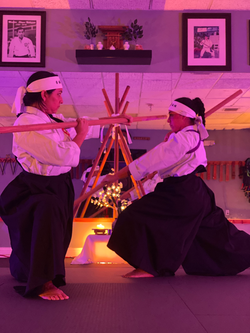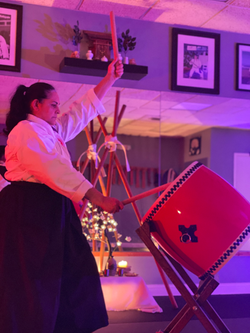

BO CEREMONY
It is celebrated during the full moon of Okinawa around August 15th, closest date to the harvest.
According to the legend, a Siza, offspring of a lion and tiger, descends from the mountains to eat the crops.
At the beginning of the festival, symbolized by traditional costumes and clothing, the Siza faces a Bosha (expert in bo). The Bosha who is also dressed in traditional clothing by wearing a Kasuk "to tie sleeves" and Hachimaki "warrior handkerchief", must come from a family of noble blood. Accompanied by music played with native instruments, the Bosha performs a Mekata (martial movements with bo). Whoever performs the Mekata represents the leadership of the youth of each community and whose responsibility is to accept challenges from the members of other villages.
In the ceremony, the altar is arranged with three bo tied with a rope or obi (belt), representing the unity of the three kingdoms of Okinawa: Hokuzan, Chuzan and Nanzan. Inside the altar are placed different objects for the ceremony such as: candles for clarity and spirituality, salt to abate bad luck, rice symbolizing the vital sustenance, and Okinawan sake Awamori to toast. All these elements symbolize the respect for the souls and the lives of ancestors and budokas who died in battled. Once all these elements have been arranged, the Bosha performs the Mekata to the beat of the music. The lyrics of the melodies emphasize the virtue of the Bosha. At the end of the Mekata the Siza is defeated. To confirm its temporary death, the Bosha raises the head of the Siza showing it to the people of the village to symbolize good omen and a good year for the harvest.
The Bo Ceremony is unique to our style and it symbolizes a year of prosperity, unity and harmony. Following the tradition, the participants in the Bo Ceremony must perform Kumibo (combat with bo) energetically to honor the festivity and the memory of our ancestors. Finishing the Kumibo, the Sensei offers to toast with his students who confirm their loyalty by accepting the toast. To conclude the ceremony, the student with the highest rank performs a Mekata.



 |  |  |
|---|---|---|
 |  |  |
 |  |  |
 |  |  |
 |  |  |
 |  |  |
 |  |  |
 |  |  |
 |  |  |
 |  |  |
 |  |  |
 |  |  |
 |  |  |
 |  |  |
 |